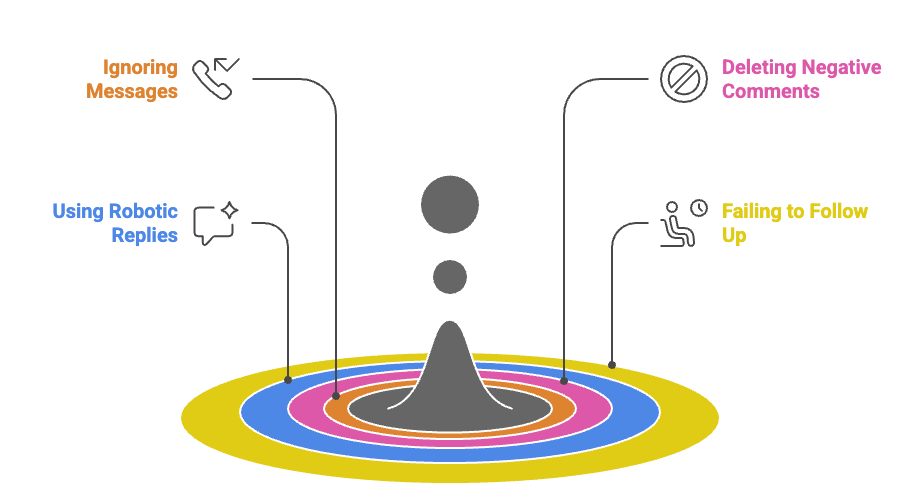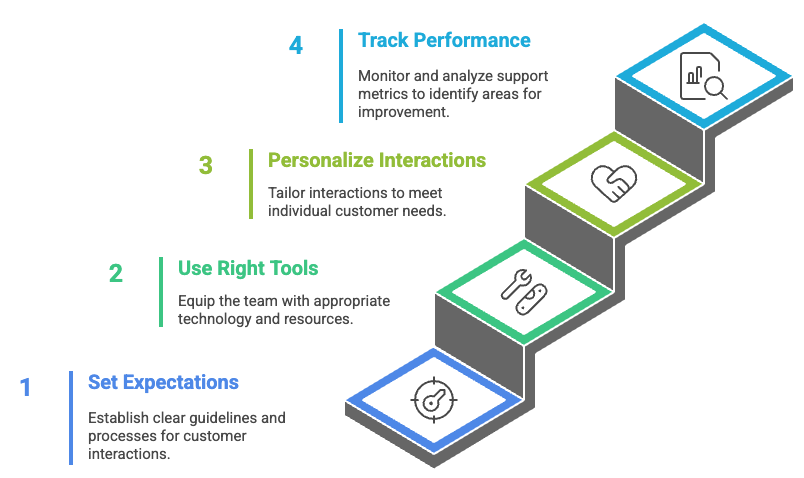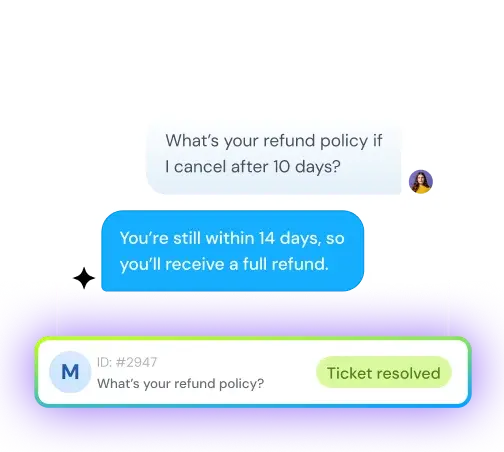Why your social media customer service is failing (And how to fix it)
Vaishali Jayaprakash
Sep 30, 2025

Your business might be losing loyal customers through social media customer service without you noticing it. Customer loyalty drops when brands don't respond to complaints on social media. You could lose half your customers just like that.
Most companies offer customer service through social channels. Your social media customer care strategy isn't just a nice-to-have anymore - it's crucial to stay competitive.
Customers want quick responses on social media. Most expect replies within an hour, and some want them in under five minutes. Support teams often find these timelines challenging. The bright side? Small improvements to your social media customer service strategy can make a huge difference. About 88% of customers are more likely to buy again after receiving good service.
Let's look at why your social media support might not work and how you can revolutionize your customer interactions from frustrating to fantastic.
Common mistakes in social media customer care
Many businesses mess up their customer service on social platforms despite their best intentions. These mistakes push customers away and harm their brand reputation.

Not responding to all messages
The silent treatment costs businesses dearly in social media customer care. Nearly one-third of customer complaints are never answered, and social media sees the most ignored messages. This silence tells customers everything they need to know.
Customers who don't get responses on social platforms:
- More likely to buy from competitors
- Cut their brand advocacy in half
- Immediately think less of your brand
Customers expect answers within 24 hours. The average business takes 28 hours to respond on Facebook. This gap between what customers want and what they get creates frustration that spreads beyond their first complaint.
Deleting negative comments
Brands often want to remove negative feedback to protect their image. All the same, this strategy usually backfires.
Removing comments:
- Shows customers their feedback doesn't matter
- Makes people think you're hiding something
- Hurts your customer relationships even more
You should only remove comments that contain spam, abusive language, or break your community guidelines. Negative feedback helps you improve and shows potential customers how you handle problems openly.
Using generic or robotic replies
Social media users want real human interaction - two-thirds say they prefer responses from people, not bots. Your canned responses and automated replies without personal touches can:
- Make you seem out of touch
- Leave customers feeling ignored
- Make things worse instead of better
AI works well for simple questions but struggles with complex issues that need empathy and problem-solving..
Failing to follow up after resolution
Your job isn't done after answering the first complaint. Not following up leaves customers hanging mid-resolution.
This mistake means:
- Customers wonder if you fixed their problem
- You miss chances to turn angry customers into fans
- You can't complete your improvement process
A follow-up proves you care about more than just closing tickets. It also helps you spot recurring problems that might need company-wide solutions.
Fix these four mistakes and you'll build stronger customer relationships through social media. The next sections will show you exactly what to do instead.

Fix 1: Set clear expectations and workflows
A good social media customer service system will eliminate chaos and frustration. Clear guidelines help customers and support teams understand what they can expect.
Define support hours and response times
Social platforms create high expectations - 52% of customers want answers within an hour. Most businesses can't offer round-the-clock support. The best approach is simple: be transparent.
Your official support hours should match:
- Peak times when customers need help
- Your team size and available resources
- How urgent typical requests are
Make these hours visible on all your platforms. Put them in your bio, pin them to your profile, and add them to about sections. Set realistic response time expectations - it's okay to tell customers you can't reply right away.
As you grow, you might need different hours for each platform. Research shows customers want faster responses on X (formerly Twitter) than on LinkedIn. You should also list which languages your team speaks, just like Nike does with its service accounts.
Use auto-replies to manage off-hours
Auto-replies become your brand's voice when your team isn't around. These messages let customers know you got their message during off-hours and tell them when they'll hear back.
Your auto-reply should:
- Thank customers who reach out
- Tell them exactly when they'll get a human response
- List other ways to get help if needed
- Show your time zone
Here's an example: "Thanks for contacting [business name]. Our support team works Monday-Friday, 9am-6pm EST. We'll respond to your message when we return tomorrow. Need urgent help? Email [email protected]."
Auto-replies work just like out-of-office emails - your platform sends preset messages during specific times. Your agents can review and respond to messages later, and customers won't feel ignored.
Each department might need its own auto-reply. Customer service needs different messages than sales or operations teams.
Create escalation paths for complex issues
Some problems need more than basic support. Good escalation paths help tough issues reach the right people quickly. This keeps both customers and staff in the loop.
Build your support in tiers:
- Tier 1: Handles basic questions using saved replies
- Tier 2: Takes care of issues needing specific knowledge
- Tier 3: Manages critical problems like billing or service outages
Each tier needs specific triggers that automatically move issues up. Issues that stay open for 24 hours might move to the next support level automatically.
Put the whole escalation process in a knowledge base where team members can find it easily. Show who handles which problems, how to pass them along, and expected response times.
Your social team needs authority to help customers. If they must get approval for every discount or refund, you'll lose the speed that makes social media support valuable.
A clear workflow helps everyone. Customers know when they'll get help. Agents understand their job. Complex issues get solved faster through proper channels.
Fix 2: Use the right tools for customer support
The right customer service tools can reshape the scene of chaotic social media support into a simplified process. Your team needs proper technology to keep up with customer expectations - 79% of consumers expect brands to respond within 24 hours and 40% want answers within the hour.
Adopt a unified social inbox
Support teams face chaos when managing messages on multiple platforms. A unified social inbox brings every customer conversation into one dashboard, whatever platform they use.
A unified inbox lets your team:
- View comments, direct messages, reviews, and mentions from all platforms at once
- Filter conversations by location, topic, or status to prioritize what matters
- Give specific team members message ownership to avoid duplicate responses
- See who handles what as it happens
Marketing teams create social accounts that add more customer service work. A unified inbox ties these efforts together and saves time when sharing information between support channels.
Use AI for sentiment analysis
AI-powered sentiment analysis helps you grasp both customer messages and their emotional tone. These tools scan incoming messages and label them as positive, negative, or neutral.
This technology brings key benefits:
- Spots urgent issues that need quick attention
- Catches emotional hints like anger, frustration, joy, or sarcasm
- Ranks messages based on customer mood
- Helps teams respond to problems early
Companies that make informed decisions are 23 times more likely to acquire customers than competitors and 19 times more likely to see above-average profits. Sentiment analysis provides this applicable information.
Fix 3: Personalize every interaction
Personalization is the best way to build real connections with customers on social media. Deloitte's research shows that businesses using personalization see 1.5 times higher customer loyalty rates than their competitors. Your social media customer service strategy should make every interaction personal.
Address customers by name
A customer's name is your simplest yet best personalization tool. This basic courtesy shows respect and tells them they're more than just a ticket number. Many brands still stick to generic responses.
Here's how to use customer names:
- Place it naturally at the start or end of your response
- Use it once or twice - that's enough
- Double-check pronunciation or preferred names if you're unsure
Names can turn basic service into experiences that make customers come back. Yes, it is true that using names shows customers you see them as people, not just users.
Reference past interactions
Customer history creates stronger connections than just using names. Your brand builds trust by remembering previous purchases and conversations.
Your team needs access to customer interaction records first. They should weave specific details from past conversations into responses. This information helps them suggest relevant products or solutions.
This strategy saves customers from repeating themselves. They feel valued by your brand and reward you with loyalty and word-of-mouth.
Adapt tone based on customer mood
Your message's tone plays a crucial role in how customers receive it. Customer responses tell you if you need to adjust - whether to be more professional, playful, or understanding.
Match your tone to how customers feel:
- Use an apologetic, compassionate tone with upset customers
- Keep responses helpful and friendly for casual questions
- Balance formality with personal touch in professional settings
Customers often prefer a casual tone that makes your business feel accessible. They feel safer sharing their concerns this way. The right tone can prevent issues from escalating.
Personal touches like names, history references, and the right tone turn everyday social media support into meaningful customer experiences.
Fix 4: Track performance and improve
Measuring the right metrics is vital to enhance your social media customer service performance. Your team can't identify areas of improvement or celebrate successes without proper measurement systems in place.
Measure CSAT and response time
Customer Satisfaction Score (CSAT) shows your customers' happiness with your service. The formula to calculate CSAT is simple: (Number of satisfied customers (4 and 5) / Number of survey responses) x 100 = % of satisfied customers.
Send a quick survey to customers after resolving their social media issues. Ask them: "How would you rate your overall satisfaction with the service you received?" The scale should range from 1 ("Very unsatisfied") to 5 ("Very satisfied").
First Response Time (FRT) tells you how quickly your team responds to customers. Calculate this metric by dividing total first reply time by the number of resolved tickets. Most customers expect a response within 24 hours.
Use tags to categorize issues
Tags make it easy to spot patterns in customer problems. Your team should create specific terms that automatically apply to incoming conversations. These classifications simplify reporting and highlight common issues quickly.
Tagged conversations help you:
- Understand your customers' most frequent questions
- Find gaps in your help center or FAQs
- Spot product issues early
This approach creates a feedback loop that streamlines improvements throughout your business.
Review agent performance regularly
Your team should check metrics to identify trends and opportunities. A comprehensive customer service report should include:
- CSAT score comparisons over time
- Resolution time improvements
- Successful actions that boosted scores
Set quarterly or monthly goals to improve CSAT scores. Speaking directly with satisfied and unhappy customers reveals your team's strengths and weaknesses.
Regular analysis helps identify process adjustments and training needs, which ended up raising your social media customer service standards.
Conclusion
Social media customer service plays a crucial role in business success. Today's customers expect quick, tailored responses when they reach out on Instagram, Facebook, or Twitter. All the same, many businesses can't keep up with these expectations.
You've seen why your social media customer support might be failing. Silent treatment, deleted comments, robotic replies, and poor follow-up push customers away. These problems are systemic and fixing them isn't just good practice—your business survival depends on it.
A simple four-step approach can reshape the scene. Start by setting clear expectations about response times and support hours. Then invest in tools that combine messages and provide customer context. Make every interaction count by using names and adapting your tone. Finally, track your performance to spot areas where you can improve.
Even small improvements in your social media customer service can deliver substantial returns. Responding well on social platforms goes beyond handling complaints—it builds relationships that turn frustrated customers into loyal supporters.
Your social channels do more than marketing. They're vital touchpoints that make or break customer experiences. These improvements will turn your social media presence from a potential weakness into a powerful tool for customer satisfaction and business growth.
Quick summary: Why your social media customer service is failing (and how to fix it)
Many businesses fail at social media customer service without realizing the impact. Customers expect fast, personalized replies, but mistakes like ignoring messages, deleting negative comments, using robotic replies, and failing to follow up push them away.
To fix this, businesses should:
Set clear expectations and workflows – define response times, use auto-replies for off-hours, and create escalation paths.
Use the right tools – unify conversations in one inbox and leverage AI for sentiment analysis.
Personalize interactions – use names, reference past conversations, and adapt tone to customer moods.
Track and improve performance – measure CSAT and response time, use tags for patterns, and review agent performance regularly.
Done right, social media support turns complaints into loyalty, builds trust, and drives business growth.
Frequently Asked Questions
Social media customer service is crucial because it directly impacts customer loyalty and sales. Responding promptly to customer inquiries on social platforms can increase customer retention, while ignoring complaints can lead to a 50% decrease in customer loyalty and potential loss of business to competitors.
Common mistakes include not responding to all messages, deleting negative comments, using generic or robotic replies, and failing to follow up after resolving issues. These errors can damage customer relationships and brand reputation.
A social media customer service job involves managing customer queries, complaints, and feedback across social platforms. The role ensures quick, helpful, and brand-aligned responses to build loyalty.
Social media plays a key role in customer service by providing real-time, accessible channels for customers to ask questions, share feedback, and resolve issues quickly. It also helps brands build stronger relationships, improve transparency, and boost customer loyalty.
Businesses can personalize social media interactions by addressing customers by name, referencing past interactions or purchases, and adapting their tone based on the customer's mood. This approach helps create deeper connections and improves overall customer satisfaction.
